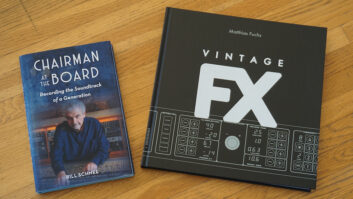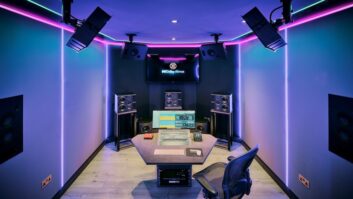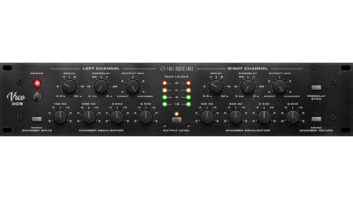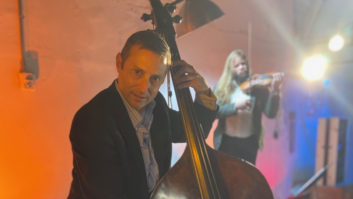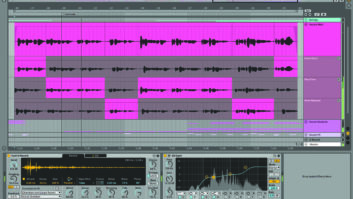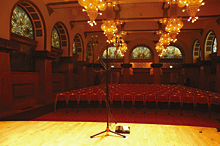

Excitement rippled through the world of classical music as news spread of the discovery of the long-lost 1735 Hart Giuseppe Guarneri del Gesù violin. It was discovered in the French countryside last year and brought to the Stradivari Society in Chicago for authentication and restoration.
“The finding of this violin is the most important discovery in our field in the last 50 years,” says Geoffrey Fushi, chairman of the society, which arranges loans of exceptional violins to promising young artists to help showcase their talents. “It is a glorious and spiritual violin of the highest order. We thought to rename this instrument the ‘Oh, my God’ violin because every fine violinist, after playing it for some seconds, would generally exclaim, ‘Oh, my God!’ It is the single greatest-sounding violin that the Stradivari Society has ever encountered.”
The DPA mic setup onstage in Rudolph Ganz Memorial Hall
All photos: Bruce Myers
While rare instruments are often used in performance, passed down from violinist to violinist in the cherished tradition of string playing, many violins have been lost, stolen, silenced behind glass in museums or kept out of reach in private collections. The Stradivari Society is as committed to documenting and recording the sound of the great instruments as they are to getting them into the hands of promising young musicians. “We are not doing history justice,” says Stradivari Society audio/visual director Larry Kapson, “if we let these rare instruments pass through our hands and not capture them.”
In 1998, Robert Bein and Fushi (as Bein & Fushi) published The Miracle Makers, a three-CD recording that captured the voices of 15 Stradivari and 15 Guarneri violins, accompanied by a book of pictures and the histories of each. The recording was designed to allow the listener to compare the tonal qualities of each instrument, offering a remarkably natural and vivid sound quality.
When the restoration of the Hart Guarneri was completed this past fall, Fushi wanted to document the instrument’s incredible sound in case it was lost or destroyed, or put out of reach in a private collection or museum. Faced with the challenge of capturing the violin’s ethereal and magical voice, Fushi contacted Bruce Myers, president of DPA Microphones.

“Brilliant Barati” plays the rare Hart del Gesù.
“I have found that DPA microphones give a mirror image of the sound,” says Fushi. “When we are able to record at the highest fidelity with all the nuance of sound and color, that’s what we want so we have a document of how each instrument sounds.” DPA Microphones has collaborated with the Stradivari Society on several projects around the world, including a recital at the Forbidden City in China and Hungarian violinist Kristof Barati performing with a full orchestra at St. Peter’s church in Zurich, Switzerland. Immediately recognizing this project’s historic importance, Myers agreed to provide all of the equipment and expertise necessary as long as the Society could provide a venue and a violinist.
Fushi quickly secured the breathtaking Rudolph Ganz Memorial Hall, located a few doors down from the Stradivari Society. Ganz Hall is housed within the Auditorium Building on Roosevelt University’s Chicago campus. The venue is one of Chicago’s ultimate examples of artistic and architectural collaboration, featuring the work of Albert Fleury; Louis Millet and George Healy; and Louis Sullivan, Dankmar Adler and their then-apprentice, Frank Lloyd Wright. The small hall is an ideal space for solo violin, and its unique suspension system greatly reduces outside noise intrusion. With the venue decided, the search was on for a musician.
A PERFECT MUSICAL PAIRING
A spectacular recital was held in January 2000 at Ganz Hall to introduce Hungarian violinist Kristof Barati to Chicago. Barati has been described as one of the most talented violinists of many generations, combining virtuosity with a deep musical sensibility. “Brilliant Barati,” as he has been nicknamed by the press, is one of the most exciting personalities to emerge out of Europe’s new generation of violinists.
Barati has performed in the concert halls of Venezuela, France, Hungary, the U.S. and Japan, winning international awards. He won his first international competition at age 16 at Italy’s Gorizia Competition, before going to Paris to study with Professor Eduard Wulfson, who was a pupil of Yehudi Menuhin. In 1997, Barati won third prize and the Prize of the Public at the Queen Elizabeth Competition in Brussels, Belgium. The special performance for solo violin in 2000 at Ganz Hall was planned by Wulfson in collaboration with the Stradivari Society.
To pair these young musicians with extraordinary instruments, the society finds buyers for rare Stradivaris and Guarneris, administers loans, arranges for insurance and maintenance of the instruments, and acts as liaison between artist and patron. One condition of the agreement is that the patrons are each rewarded with an annual concert by the artist to whom they have loaned an instrument. Under the loan program, Barati has the privilege to play on a 1703 Stradivari named “The Lady Harmsworth” (estimated value $4 million). When Barati made his annual trip to the Stradivari Society to bring in the instrument for maintenance, the restoration of the Hart del Gesù in Chicago had just been completed. At the request of Fushi, Barati agreed to play the Hart Guarneri for this historic recording in Ganz Hall.
RECORD-READY
Now that the stage was set, the focus turned toward recording equipment. Matched pairs of 14 different DPA microphones were assembled. DPA HMA5000 mic preamps were chosen (with HTP4000 48-volt converters where required) because they’re designed to offer the same high-resolution, uncolored sonic signature that mirrors the DPA microphones. For conversion, Digital Audio Denmark (DAD) ADDA 2408 8-channel, 24-bit/96kHz models were selected for their “nondigital” sound and high level of detail. To keep the 24/96k signal chain as streamlined as possible, the team chose Steinberg Nuendo because they felt that the application left the signal untouched beyond pure level adjustment. An HP Pavillion zv6000 (XP Pro) laptop ran Nuendo 3, and gear was powered by a balanced AC unit designed and built by Mike Morgan.
Engineering assistance was provided by Gary Baldassari, technical consultant to DPA. “Overall, this was the most minimalistic signal path that we could achieve, giving us a recording completely devoid of limiting, compressing or any kind of signal processing,” Baldassari says. “All that will be heard in these recordings is the fundamental difference in sonic signature of the microphones themselves.”
The recording’s purpose had become twofold: not only to make the finest recording possible to capture the violin for history, but also to create a set of discs that allow the comparison and evaluation of the entire line of DPA recording microphones. The recordings offer a side-by-side comparison of the effects of the seven acoustic modifiers used with DPA’s 16mm omni capsule, as well as the ability to compare cardioids to wide cardioids, 130V models to traditional 48V versions, and solid-state to tube-version large-diaphragm 4041 models.
Mics were placed onstage, about two meters from the performer, at instrument height. During recording, the number of mics that could be used for each take had to be limited to avoid phase inconsistencies caused by the mics not being placed in the same relative space, so special stereo bars were developed to hold four pairs of mics at one time. Mics were placed 40 cm apart on the bar, on-axis. The same pair of “reference” mics was used in each recording to maintain a baseline, while the other three pairs changed for each take. Fifty-foot cable ran to the recording rig, which was racked in a flight case located in the foyer for isolation. Monitoring also took place in the foyer, out of Nuendo into a Mytek 24/96 D/A/headphone amp powering Ultrasone PROline 750 and Grado Signature headphones.

Close-up view of the DPA microphone array onstage: Custom stereo bars held four pairs of mics at one time.
Once all of the recording equipment was in place, the only change between takes would be the swapping of the stereo bars. Barati stood before the stereo pairs and presented the piece over and over again onstage.
THE HISTORIC CONCERT
For Barati, returning to Ganz Hall — where he had first played for the Chicago patrons — was like a homecoming. He entered with his musical advisor, Wulfson. Myers asked Barati to select a piece that would show off the violin’s attributes — the projection, dynamics and soft, sweet tones. It would have to be a piece that he could play over and over again, and he chose Johann Sebastian Bach’s “Gavotte” from the E-major Partita BWV 1006. Barati had to play 14 takes to allow all of the different microphone models to be recorded.
Barati stood alone on the stage, his only audience the four cameras stationed around the hall, and the sound and video crew who was there to record him. He played the passage over and over, with passion for the music and feeling for the instrument that was palatable to the few who were privileged to witness his performance. His purity of tone and commanding depth of sound filled the hall with warm, wonderful music.
The final recording session, which took place late in a day that had become much longer than planned, was again a selection by Barati. He wanted to perform Bach’s “Chaconne” from the D-minor Partita BWV 1004, a piece that showed off the Guarneri in all of its glory, as well as Barati’s virtuosity. Brahms once said of this Bach piece: “If I imagined that I could have created, even conceived the piece, I am quite certain that the excess of excitement and earth-shattering experience would have driven me out of my mind.”
This final performance was captured with the reference set of DPA 4006TLs that had been included with each group of four mics used throughout the day. Even those who had watched Barati play all day long were left breathless by his performance of the incredibly difficult piece. His fingers flew up and down the instrument, notes rippling and darting under his almost gymnastic handling of the bow and violin.
The recordings were processed into a two-CD set of comparison recordings by DPA Microphones. Also included is the bonus track of Barati’s final recording of the “Chaconne” piece and a video DVD of his performance at Ganz Hall, filmed by Kapson.
“It is a pleasure to know that the recording session will be in print,” Barati says of the project. “It was a great experience to record Bach’s “Gavotte” each time in the same way, with minimum alteration on the interpretation. I hope all professionals can utilize the recordings of this very special session.”
“We were honored to work with the Stradivari Society and an incredible talent like Kristof,” said Myers of the finished product. “Not only do we have an invaluable tool to offer our customers to help them understand the subtle differences in the models, but we have also captured a virtuoso performance on a historic instrument that has brought a tear to the eye of many who are fortunate enough to watch it.”
Shortly after the recording was made, the Hart Guarneri was purchased by a wealthy Russian industrialist, and it is currently in Germany on loan to a Russian violinist.
The Instrument, The Legacy
Giuseppe Guarneri del Gesù (1698-1744) is the only luthier to rival Antonio Stradivari with regard to the respect and reverence accorded his instruments. (He is known as del Gesù because the labels he put inside his instruments incorporated the Christian nomina sacra I.H.S. and a Roman cross.) His instruments diverged significantly from family tradition, becoming uniquely his own style. They are generally considered equal in quality only to those of Stradivari, and some argue that they are superior. Guarneri’s instruments are certainly more rare, as only approximately 140 of them still survive, as compared to approximately 650 Stradivaris. The recently discovered instrument is considered the best of the early period of del Gesù violins and is one of the Top 10 best examples of Guarneri’s overall production. Its condition is remarkable because it was kept within a single family for more than 100 years; its current value is estimated at $6.5 million.
Well-known violinists such as Eugène Ysaÿe, Jascha Heifetz, Isaac Stern, Itzhak Perlman and Sarah Chang have played del Gesùs at one point in their career, or even exclusively. The famed violin virtuoso Niccolò Paganini’s favorite instrument, Il Cannone Guarnerius, was a Guarneri del Gesù violin of 1742, and the Lord Wilton Guarneri del Gesù violin, also made in 1742, was once owned by violinist/conductor Yehudi Menuhin.
“The violins of Stradivari and Guarneri have been enchanting to both violinists and audiences alike for over two centuries,” says Geoffrey Fushi. “Works of art unto themselves, these instruments remain unrivaled in their beauty of craftsmanship and broad palette of tonal color. The instruments of these legendary violin-makers are at the heart of a mythology of almost biblical proportions. And the mystery surrounding the creation of these rare and precious instruments that cannot be reproduced furthers our fascination with their magical tonal qualities, charm and power.”
— Nick Pagano



